ISAAA Brief 53-2017: Executive Summary
Biotech Crop Adoption Surges as Economic Benefits
Accumulate in 22 Years
INTRODUCTION
Biotech crops in the last 22 years of commercialization have brought immense economic benefits, health improvement and social gains which should be shared with the global community. Accurate information on the benefits and potentials of biotech crops will allow farmers and consumers to make informed-choice in what crops to grow and consume, respectively; policy makers and regulators to craft enabling biosafety guidelines for commercialization and adoption of biotech crops; and science communicators and the media to facilitate dissemination of the benefits and potentials of the technology.
In consonance with the above, the International Service for the Acquisition of Agri-biotech Applications has been publishing the annual series of Global Status of Commercialized Biotech/GM Crop or ISAAA Briefs since 1996. Brief 53is the 22nd of the series which documents the latest information on the subject, and presents the global database on the adoption and distribution of biotech crops in 2017, as well as the accumulative data since 1996 (the first year of commercialization), country situations, trends in approval of biotech crops, and future prospects of the technology in biotech crop growing and importing countries.
Dr. Clive James, founder and emeritus chair of ISAAA, has painstakingly authored the first 20 annual reports making the ISAAA Brief the most credible source of information on biotech crops in the last two decades. He has been a great advocate of the technology and biotech products following the footsteps of his great mentor and colleague the late Nobel Peace Laureate Norman Borlaug, who was also the founding patron of ISAAA. Starting in 2016, the ISAAA Brief continues this tradition of providing an up-to-date report on biotech products from information gathered through a global network.
HIGHLIGHTS OF THE 2017 ADOPTI ON OF BIOTECH CROPS
-
Biotech crop area in 2017 attains new record-high adoption at 189.8 million hectares worldwide.
On the 22nd year of commercialization of biotech/GM crops in 2017, 24 countries grew 189.8 million hectares of biotech crops – an increase of 4.7 million hectares (11.6 million acres) or 3% from 185.1 million hectares in 2016. Except for the 2015 adoption, this is the 21st series of increases every single year; and notably 12 of the 18 years were double-digit growth rates.
-
Adoption rates of top five biotech crop growing countries reached close to saturation
The average biotech crop adoption rate in the top five biotech crop-growing countries increased in 2017 to reach close to saturation, with USA at 94.5% (average for soybeans, maize and canola adoption), Brazil (94%), Argentina (~100%), Canada (95%), and India (93%). Expansion of biotech crop areas in these countries would be through immediate approval and commercialization of new biotech crops and traits to target problems related to climate change and emergence of new pests and diseases.
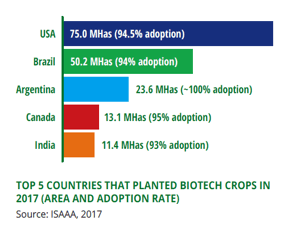
-
Biotech crops increased ~112-fold from 1996, the fastest adopted crop technology in the world; accumulated biotech area at 2.3 billion hectares
Global area of biotech crops has increased ~112-fold from 1.7 million hectares in 1996 to 189.8 million hectares in 2017 – this makes biotech crops the fastest adopted crop technology in recent times. An accumulated 2.3 billion hectares or 5.9 billion acres were achieved in 22 years (1996-2017) of biotech crop commercialization.
-
67 countries adopted biotech crops – 24 countries planted and 43 additional countries imported
The 189.8 million hectares of biotech crops were grown by 24 countries – 19 developing and 5 industrial countries. Developing countries grew 53% (100.6 million hectares) of the global biotech crop area compared to 47% for industrial countries. An additional 43 countries (17 + 26
EU countries) formally imported biotech crops for food, feed and processing. Thus, a total of 67 countries have adopted biotech crops.
-
Biotech crops provide more diverse offerings to consumers in 2017
Biotech crops have expanded beyond the big four (corn, soybeans, cotton, and canola) to give more choices for many of the world’s consumers and food producers. These biotech crops include alfalfa, sugar beets, papaya, squash, eggplant, potatoes, and apples, all of which are already in the market. Two generations of Innate® potatoes with non-bruising, non-browning, reduced acrylamide and late blight resistant traits were planted in the USA and Canada, and non-browning apples in the USA. Bt eggplant adoption in Bangladesh increased to 2,400 hectares on its fourth year of commercialization, 25 hectares of biotech pink pineapple in Costa Rica, increased ear biomass and high amylose content maize, and soybeans with modified oil content. An insect resistant sugarcane was approved by Brazil for commercialization in 2018.
Additionally, biotech crop researches conducted by public sector institutions include rice, banana, potato, wheat, chickpea, pigeon pea, mustard, cassava, cowpea, and sweet potato with various economically-important and nutritional quality traits beneficial to food producers and consumers in developing countries.
-
Biotech soybeans covered 50% of global biotech crop area
The four major biotech crops -- soybeans, maize, cotton, and canola -- in decreasing area, were the most adopted biotech crops by 24 countries. Soybeans lead at 94.1 million hectares at 50% global biotech crop adoption, a 3% increase from 2016. This is followed by maize (59.7 million hectares), cotton (24.21 million hectares) and canola (10.2 million hectares). Based on the global crop area for individual crops, 77% of soybeans, 80% of cotton, 32% of maize and 30% of canola were biotech crops in 2017.
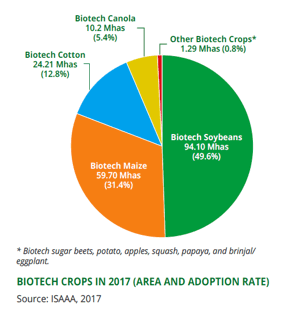
The area planted to biotech crops with stacked traits increased by 3% and occupied 41% of the global biotech crop area
Stacked traits with insect resistance and herbicide tolerance increased by 3% and covered 41% of the global area, a testimony to farmers’ adherence to smart agriculture with no till and reduced insecticide use. Herbicide tolerance in soybeans, canola, maize, alfalfa, and cotton, has consistently been the dominant trait which in 2017 covered 47% of the global area – an increase of 2% compared to 2016.
-
Top five countries (USA, Brazil, Argentina, Canada and India) planted 91.3% of the global biotech crop area of 189.8 million hectares
USA led biotech crop planting in 2017 at 75 million hectares, followed by Brazil (50.2 million hectares), Argentina (23.6 million hectares), Canada (13.1 million hectares) and India (11.4 million hectares) (Table 1) for a total of 173.3 million hectares, representing 91.3% of the global area and benefiting more than 1.95 billion people in the 5 countries or 26% of the 2017 world population of 7.6 billion.
The USA reached an average 94.5% adoption rate for plantings of biotech soybeans, maize and cotton
The area of biotech crops planted in 2017 in the United States of America (USA) remained the highest globally at 75.04 million hectares, comprised of 34.05 million soybeans, 33.84 million hectares maize, 4.58 million hectares cotton, 1.22 million hectares alfalfa, 876,000 hectares canola, 458,000 biotech sugar beets, 3,000 hectares biotech potato, and some 1,000 hectares each of biotech apples, squash and papaya. Generally, the area planted to biotech crops increased in the USA except for maize and sugar beets. The lesser drought incidence and lesser storms that bypassed the crop growing areas across the country as well as the favorable and profitable prices for soybeans, cotton, and canola, were enough incentives for farmers to increase the area of these three biotech crops. The average near saturation biotech adoption rate of 94.5% from the three major crops: maize, soybeans, and cotton may mean minimal increases expected in the coming years. Thus, further expansion in biotech crop area depends on the adoption of other biotech crops: canola, alfalfa, sugar beets, potato, and apples. The USA leads the bandwagon in the discovery, development, and commercialization of biotech crops. The current revamp on biotech regulations of the three government regulatory agencies should reflect the country’s leadership in acceptance and recognition of the scientific basis of the technology. Expeditious approval of new products of agri-biotechnology benefits not only the USA, but also the global community.
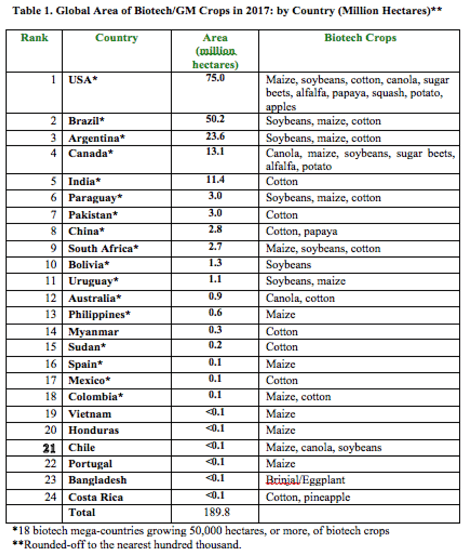
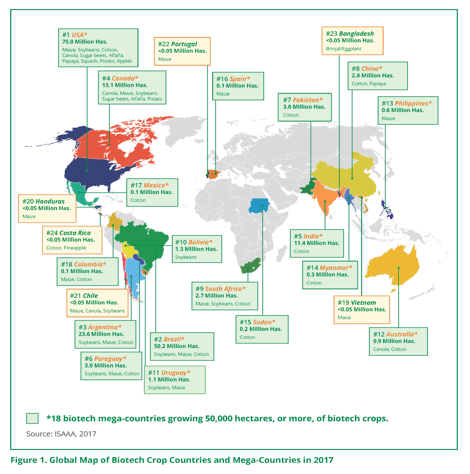
Brazil expanded biotech crop area to reach 50.2 million hectares
Brazil planted the second highest area of biotech crops globally in 2017 at 50.2 million hectares compared to 49.1 million hectares in 2016, a 2% increase or 1.1 million hectares, and represents 26% of the global biotech area of 189.8 million hectares. The biotech crops planted in the country include soybeans at 33.7 million hectares, maize (summer and winter) at 15.6 million hectares, and cotton at 940,000 hectares. The total planted area of these three crops in Brazil was 53.4 million hectares, a 1% increase from 52.6 million hectares in 2016. The 50.2 million hectares of biotech crop area is a 94% adoption rate, a 1% increase from 2016. The area grown to biotech soybeans and cotton increased significantly in 2017 compared to 2016 due to profitability, higher prices, high market demand both domestically and internationally, and available seed technologies. Slight reduction in biotech maize was due to low current prices and the expansion of soybean area in the country. Future expansion of these three biotech crops may come with the increasing domestic and global demand for protein for food and animal feeds, biofuel production (biodiesel for soybeans and ethanol for maize), and raw cotton materials.
Various biotech crops in the pipeline include sugarcane, potato, papaya, rice and citrus. New biotech products such as biotech dry edible beans, biotech eucalyptus and the recently approved sugarcane will be available by 2019/20. With the increasing adoption of biotech crops in the country, knowledge on protecting the technology among farmers and crop producers is essential and steps have to be taken to this end.
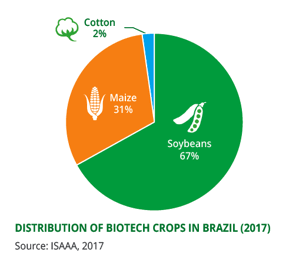
Argentina reached close to 100% adoption rate of biotech crops
Argentina is one of the leading exporters of biotech soybeans, cotton, and maize, planted at a total of 23.6 million hectares, 12% of the global biotech crop area of 189.8 million hectares. Argentina had a slight decrease of biotech crop area in 2017 compared to 2016 at 23.82 million hectares. The slight decrease was due to reduced planting of biotech soybeans at -3% (from 18.7 million hectares in 2016 to 18.1 million hectares in 2017), and -38% (from 380,000 hectares in 2016 to 250,000 hectares in 2017) for biotech cotton. The area planted to biotech maize increased by 10% from 4.7 million hectares to 5.2 million hectares. Average adoption rate of the three biotech crops was close to 100% indicating the country’s reliance on the technology to drive its economy. In 2017, however, Argentina experienced climatic problems during the planting season for soybeans, maize and cotton. This affected the total biotech crop area which, similar to 2016, was about -3% which was due to the decline in soybean and cotton areas. The maize area however increased by 10%. With the government’s plan to revolutionize agriculture accompanied by reduction in export tax, as well as the increasing demand for protein for food and feeds, locally and internationally, the soybean and maize areas are expected to increase in the very near future. Cotton area declined in two successive years but the increasing global demand for cotton could revive cotton production in the country.
Canada increased biotech crop area by 18% in 2017
Canada planted six biotech crops in 2017 at 13.12 million hectares, an unprecedented 18% increase from 11.1 million hectares in 2016, with a corresponding increase in total crops by 17% from 12.38 million hectares in 2016 to 14.49 million hectares in 2017. The biotech crops were comprised of 2.50 million hectares of soybeans, 1.78 million hectares maize, 8.83 million hectares canola, 15,000 hectares sugar beets, 3,000 hectares alfalfa, and 40 hectares potatoes, for a total of 13.12 million hectares. The average adoption rate for the four major crops of soybeans, maize, canola, and sugar beets was similar to 2016 at 95%. Large increases in biotech crop area were obtained for reduced lignin alfalfa, HT soybeans and HT sugar beets. Biotech/GE salmon has also been introduced to Canadian consumers in August 2017 while biotech apple will be in the consumer market and in orchards in the very near future. Expansion of biotech crop adoption in Canada is therefore expected with the increasing global demand for food, feed and feedstocks for ethanol and biodiesel, strong research and development in the country, excellent public acceptance of the technology, and the exemplary support of the government for biotech crops.
India: IR (Bt) cotton area increased by 600,000 hectares (6%) in 2017
India achieved a great stride in cotton production with a quarter of market share in global cotton production in 2017. Biotech cotton area increased by 6% from 10.8 million hectares in 2016 to11.4 million hectares in 2017, equivalent to 93% of total cotton area of 12.24 million hectares. Insect resistant (Bt) technology in cotton hybrids delivered broad based benefits by saving losses caused by American bollworm and boosting cotton yield to 500 kg lint per hectare. However, the next level of cotton yield target, to achieve a yield level equal to the global average cotton yield of 700+ kg lint per hectare, cannot be achieved without the introduction of new generation biotech traits including stacked traits, smart agronomy and high yielding cotton cultivars. Stewardship and resistance management strategies need to be implemented rigorously to maintain current yield levels in existing IR cotton hybrids. The unauthorized cultivation of unapproved IR/HT cotton varieties should be curbed and the infestation of pink bollworm should be properly managed at farmers’ field level. The recommendation of the regulatory agency GEAC on GM mustard, which was based on a thorough assessment of the safety and performance of GM mustard shall not go into oblivion. The moratorium on IR brinjal by the Ministry of Environment, Forestry, and Climate Change (MOEF&CC) in 2010 has not yielded any outcome in the last seven years, and thus a careful consideration of the recommendation of the regulatory agency on GM crops by the MOEF&CC is needed.
-
Ten countries in Latin America grew 79.4 million hectares of biotech crops
Ten countries in Latin America planted biotech crops in 2017 led by Brazil (50.2 million hectares), Argentina (23.6 million hectares), Paraguay (2.96 million hectares), Uruguay (1.14 million hectares), Bolivia (1.3 million hectares), Mexico (110,000 hectares), Colombia (95,000 hectares), Honduras (32,000 hectares), Chile (13,000 hectares) and Costa Rica (275 hectares) for a total of 79.4 million hectares equal to 42% of the global biotech area of 189.8 million hectares. The 79.4 million hectares is a marginal decline of 110,000 hectares biotech crops planted in 2016 in Latin America. This decline is due to biotech area decreases in Paraguay (-16%), Uruguay (-13%), Argentina (-3%), and Bolivia (-1%) mainly because of water stresses (drought and flooding), low prices of specific commodities and local and international trade issues. Large percentage increases in biotech crop areas were recorded in Chile (23%), Costa Rica (22%), Mexico (13%), Colombia (7%), Honduras (3%), and Brazil (2%). Increases in biotech crop areas in these countries were due to profitability, higher prices, increased market demand both domestically and internationally, and presence of available seed technologies in the country. Future expansion of the major biotech crops: soybeans, maize, and cotton may come with the increasing domestic and global demand for protein for food and animal feeds, biofuel production (biodiesel for soybeans and ethanol for maize), and raw cotton materials.
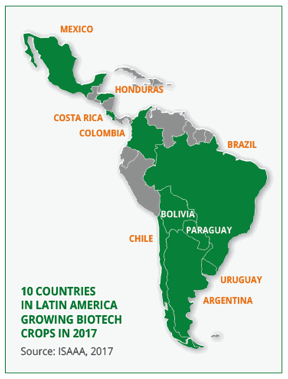
New biotech crops which can be adopted by particular countries in the future are maize and sugarcane for Bolivia, maize and resumption of soybean planting for Mexico, and soybeans for Honduras. The estimated over half a million biotech farmers in the developing countries of
Latin America have been benefiting immensely in the last 21 years of commercialization. Economic benefits estimated by Brookes and Barfoot (2018, Forthcoming) from respective country’s start year of planting till 2016, was over US$46.9 billion and for 2016 alone, was about US$6.5 billion. These are enormous benefits that can only be derived from biotech crops, and non-adoption of biotech crops in these countries will result in huge opportunity costs that will escalate poverty, hunger, malnutrition and political instability.
-
Eight countries in Asia and the Pacific grew 19.1 million hectares of biotech crops
Biotech countries in the Asia and Pacific region were led by India with the biggest area of biotech crops at 11.4 million hectares of cotton followed by Pakistan (3 million hectares cotton), China (2.78 million hectares cotton), Australia (924,000 hectares cotton and canola), the Philippines (642,000 hectares maize), Myanmar (320,000 hectares cotton), Vietnam (45,000 hectares maize) and Bangladesh (2,400 hectares eggplant). This region planted 19.11 million hectares of biotech crops, 10% of the global biotech crops of 189.8 million hectares. There was an overall increase in biotech crop area of 3.34% contributed mainly by increases in biotech cotton area in India (6%) and Pakistan (3.4%); Australia (8%) for biotech cotton and canola; Vietnam (29%) for biotech maize; and most notably Bangladesh (242%) for biotech eggplant. Increases in biotech crop areas in these countries were mainly due to farmers’ acceptance of the technology because of the savings on insecticide application and labor cost for India, Pakistan, Vietnam and Bangladesh; more clarified regulatory guideline and new biotech cotton varieties available in Pakistan and Myanmar; and favorable weather and increasing global demand for canola in Australia. The decrease in biotech maize area in the Philippines of 21% was due to the problem of counterfeit seeds in the country, which had occupied 10% of the market share. China’s biotech cotton area remained at 2.78 million hectares due to the country’s high year-end stocks that are still supplying the domestic needs for cotton.
The expansion of biotech crops in Asia and the Pacific Region depends on a number of factors specific to each country. Biotech cotton-growing countries of India, Pakistan, China, and Myanmar have various new biotech cotton varieties in the pipeline pending approval by their respective regulatory systems, as well as various crops and traits. In Myanmar, biotech crop regulation needs to be put in place to expedite approval and commercialization of new biotech cotton varieties and other crops/traits. Biotech research in China has produced various biotech crops with important agronomic traits including IR rice, phytase maize, HT cotton, HT soybean and many others. Finally, the estimated over 15 million biotech farmers in the developing countries of Asia have been benefiting immensely in the last 21 years of commercialization. Economic benefits estimated by Brookes and Barfoot (2018, Forthcoming) from respective country’s start year of planting till 2016 was over US$47.8 billion and for 2016 alone, by about US$3.2 billion. These are enormous benefits that can only be derived from biotech crops, and non-adoption of biotech crops in these countries will result in huge opportunity costs that will escalate poverty, hunger, malnutrition and political instability.
-
South Africa and Sudan had increased planting of biotech crops to reach 2.9 million hectares, a 4% increase from 2016
Africa sustained commercialization of biotech crops with South Africa and Sudan growing a combined area of 2.9 million hectares, an increase of 4% from the 2.78 million hectares grown in 2016. Additionally, the continent is poised to deliver new biotech crops into the global basket in the coming years given the vibrant research and advanced multi-location trials nearing commercialization for food security crops, key among them banana, cassava, and cowpea. Africa currently has 12 biotech crops in 13 countries and 14 traits under different stages of planting, experimentation and research. There is also a strong wave of endorsement of technology benefits through increased expressions of political goodwill and budget allocations by various governments. Increased biotech area in South Africa and Sudan further confirms the technology is delivering benefits. Stacked traits appear to be gaining popularity with more countries opting for their introduction even for new country entrants such as Mozambique and Tanzania. Importantly, South Africa is leading the continent in providing guidance on the regulatory narrative for new breeding techniques in order to expand the innovation platform and quickly reap benefits from these precise tools. Emerging South-South collaboration and diversification of technology providers will further boost confidence in decision making and build courage among policy makers for hastening sound science-based decisions about the technology for Africa’s benefits. These benefits were estimated to be US$2.5 billion from 1996 to 2016 and US$330 million in 2016 alone (Brookes and Barfoot, 2018, Forthcoming).
-
Two countries in the European Union continued to plant biotech maize at more than 131,000 hectares
Two countries, Spain and Portugal in the European Union have consistently planted biotech IR maize event MON810, the only biotech event approved in the EU. The total biotech crop area planted was 131,535 hectares, a slight decrease of 4% from 2016 biotech maize area of 136,363 hectares. Spain planted 124,227 hectares and Portugal at 7,308 hectares. Czech Republic and Slovakia have stopped planting in 2017 due to difficulty in marketing their biotech maize to feed millers who demand for non-biotech maize. Hence, the future of biotech crop adoption within the EU may be dim, but there are movements among the farmers, consumers, researchers and regulatory sectors that indicate possible change in acceptance and perception in the near future.
STATUS OF APPROVED EVENTS FOR BIOTECH CROPS USED IN FOOD, FEED, PROCESSING, AND CULTIVATION
A total of 67 countries (39 + EU 28) have issued regulatory approvals to genetically modified or GM crops for consumption either as human food, animal feed, as well as for commercial cultivation. Since 1992, there have been 4,133 approvals granted by regulatory authorities of these 67 countries. These were granted to 476 GM events from 26 GM crops, excluding carnation, rose and petunia.
Of these approvals, 1,995 are food, either for direct use or for processing, 1,338 are feed use, for direct use or processing, while 800 are for environmental release or cultivation. Japan has the most number of GM events approved, (not including intermediate events from approved stacked and pyramided events), followed by U.S.A., Canada, Mexico, South Korea, Taiwan, Australia, European Union, New Zealand, Colombia, Philippines, South Africa and Brazil. Maize still has the most number of approved events (232 in 30 countries), followed by cotton (59 events in 24 countries), potato (48 events in 10 countries), canola (41 events in 15 countries), and soybean (37 events in 29 countries).
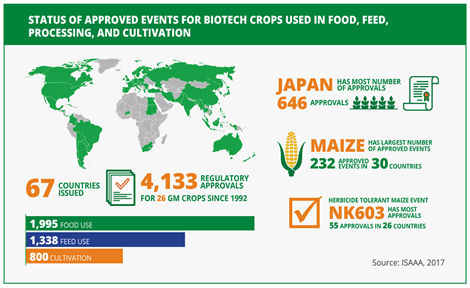
The herbicide-tolerant maize event NK603 (55 approvals in 26 countries + EU 28) still has the most number of approvals. It is followed by herbicide-tolerant soybean GTS 40-3-2 (54 approvals in 27 countries + EU 28), insect-resistant maize MON810 (53 approvals in 26 countries + EU 28), insect-resistant maize Bt11 (51 approvals in 25 countries + EU 28), insect resistant maize TC1507 (51 approvals in 24 countries + EU 28), herbicide-tolerant maize GA21 (50 approvals in 24 countries + EU 28), insect-resistant maize MON89034 (49 approvals in 24 countries + EU 28), herbicide tolerant soybean A2704-12 (43 approvals in 23 countries + EU 28), insect-resistant maize MON88017 (42 approvals in 22 countries + EU-28), insect-resistant cotton MON531 (43 approval in 21 countries + EU 28), herbicide-tolerant maize T25 (41 approvals in 20 countries + EU 28) and insect-resistant maize MIR162 (41 approvals in 22 countries + EU 28).
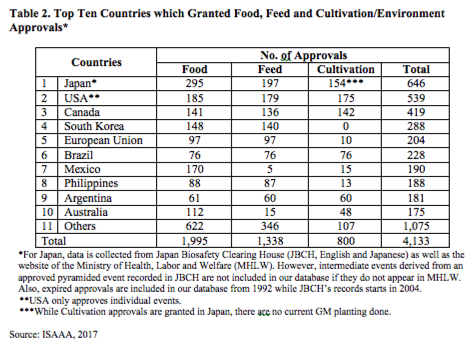
BIOTECHNOLOGY ADDRESSES GLOBAL FOOD INSECURITY:
NOW AND INTO THE FUTURE
Global food insecurity is still a leading problem in the developing world. According to the Global Report on Food Crises in 2017, around 108 million people in 48 food crisis-affected countries are still at risk or in severe acute food insecurity in 2016. This is even amidst massive and collective efforts of international organizations to address food challenges. About 60% of the hungry people are located in 19 countries facing conflict and climate change crisis situations. High risks of famine were recorded in northeast Nigeria, Somalia, South Sudan, and Yemen, where 20 million people were severely experiencing hunger. The FAO Director-General opined that in these situations, “Strong political commitment to eradicate hunger is fundamental, but it is not enough. Hunger will only be defeated if countries translate their pledges into action, especially at national and local levels. Peace is of course the key to ending these crises, but we cannot wait for peace to take action. It is extremely important to ensure that these people have the conditions to continue producing their own food. Vulnerable people cannot be left behind, especially the youth and women.”
Global population in 2017 reached 7.6 billion and is expected to reach 8.6 billion in 2030, 9.8 billion in 2050 and 11.2 billion in 2100, according to the United Nations (2017). Roughly 83 million people are added to the world’s population every year, and the upward trend is expected to continue, even if the fertility levels will continue to decline. Food experts for a long time believed that food production must increase by 70% to feed the world’s growing population.
Climate change is another challenge that can cause a 23% decline in major crop production from maize, wheat, rice, and soybeans by 2050. The protein content of crops will be reduced considerably in major staple crops: barley (14.6%), rice (7.6%), wheat (7.8%) and potatoes (6.4%) due to climate change. Other studies also point out that the zinc and iron content of staple crops will likewise be affected, whereby iron concentrations will drop by as much as 10% in maize for example, putting around 1.4 billion children at risk of major iron deficiencies by 2050.
Thus, improvements in modern crop technology and agronomic practices have to be fully utilized because they have the capacity to reduce annual fluctuations in food availability as well as maintain nutritive contents of crops. Both mitigation and adaptation technologies are crucial in combating climate change. Adoption of biotech crops is one of the most effective crop adaptation technologies to combat climate chance because crop varieties may be developed in a timely manner through modern methods of molecular biology and biotechnology to cope with salinity, submergence and drought, as well as more virulent newly emergent insect pests and plant pathogens.
CONTRIBUTION OF BIOTECH CROPS TO FOOD SECURITY, SUSTAINABILITY AND CLIMATE CHANGE
Biotech crops are being adopted globally because of the enormous benefits to the environment, health of humans and animals, and contributions to the improvement of socio economic conditions of farmers and the general public. Global economic gains contributed by biotech crops in the last 21 years (1996-2016) have amounted to US$186.1 billion economic benefits to more than 16 to 17 million farmers, 95% of whom come from developing countries.
Biotech crops contributed to food security, sustainability and climate change by:
- increasing crop productivity by 657.6 million tons valued at US$186.1 billion in 1996-2016; and 82.2 million tons valued at US$18.2 billion in 2016 alone;
- conserving biodiversity in 1996 to 2016 by saving 183 million hectares of land, and 22.5 million hectares of land in 2016 alone;
- providing a better environment
- by saving on 671 million kg. a.i. of pesticides in 1996-2016, and by 48.5 million kg in 2016 alone from being released into the environment;
- by saving on pesticide use by 8.2% in 1996-2016, and by 8.1% in 2016 alone;
- by reducing EIQ (Environmental Impact Quotient) by 18.4% in 1996-2016, and by 18.3% in 2016 alone
- reducing CO2 emissions in 2016 by 27.1 billion kg, equivalent to taking 16.7 million cars off the road for one year; and
- helping alleviate poverty through uplifting the economic situation of 16-17 million small farmers, and their families totaling >65 million people, who are some of the poorest people in the world (Brookes and Barfoot, 2018, Forthcoming).
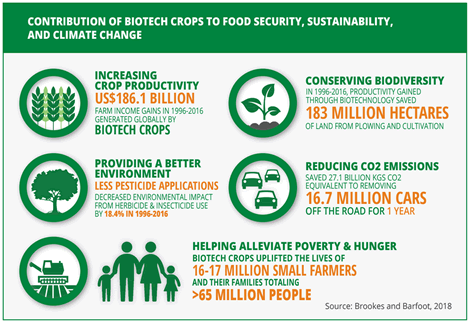
Thus, biotech crops can contribute to a “sustainable intensification” strategy favored by many science academies worldwide, which allows productivity/production to be increased only on the current 1.5 billion hectares of global crop land, thereby saving forests and biodiversity. Biotech crops are essential but are not a panacea and adherence to good farming practices, such as rotations and resistance management, are a must for biotech crops as they are for conventional crops.
ECONOMIC GAINS FROM BIOTECH CROPS REACHED $186.1 BILLION FROM 1996 TO 2016
A total of US$186.1 billion economic benefits were gained by countries planting biotech crops from 1996 to 2016. The highest gain was obtained by USA (US$ 80.3 billion), Argentina (US$23.7 billion), India (US$21.1 billion), Brazil (US$19.8 billion), China (US$19.6 billion), Canada (US$8 billion), and others (US$13.6 billion). For 2016 alone, six countries gained the most economically from biotech crops in 2016, they were USA (US$7.3 billion), Brazil (US$3.8 billion), India (US$1.5 billion), Argentina (US$2.1 billion), China (US$1 billion), Canada (US$0.7 billion), and others (US1.8 billion) for a total of US$18.2 billion. For 2017, the US$18.2 billion economic benefits comprised of US$10 billion for developing countries and US$8.2 for industrial countries.
In 2017, the global market value of biotech crops, estimated by Cropnosis was US$17.2 billion, representing 23.9% of the US$70.9 billion global crop protection market in 2016, and 30% of the US$56.02 billion global commercial seed market (Cropnosis, 2018, Personal Communication). Two industry sources projected an increase of 8.3% to 10.5% in the global value of biotech seed market by the end of 2022 and 2025, respectively. These are enormous benefits that can be obtained in the seed market if biotech crops are continuously planted globally.
OPPORTUNITY COSTS WITHOUT BIOTECH CROPS
Despite all the documented benefits discussed above, critics of biotech crops have been raising non-scientific allegations that somehow affect country regulations and approvals of biotech crops. Governments are concerned on the safety, access and profitability of biotech crops, as well as local interests on biodiversity protection and trade competitiveness. Hence, regulations become stringent which stifle access of farmers to the technology and its economic benefits. According to the Information Technology and Innovation Foundation (ITIF) study led by L. Val Giddings (2016), the current restrictive regulatory climate for agricultural biotech innovations could cost low- and lower middle-income nations up to US$1.5 trillion in foregone economic benefits through 2050. Furthermore, it is estimated that for African agricultural economies alone, the continued suppression of biotech innovations in agriculture had cost at least US$2.5 billion from 2008-2013. Thus, according to the authors, GMO critics have erected sufficient barriers to the development of the poorest nations on earth who mainly rely on agriculture for subsistence, which is a moral disaster.
In Australia, loss of opportunity for the delayed adoption of biotech canola between 2004 and 2014 was estimated in a report by Biden et al (2018). The report indicated “that the environmental opportunity costs from delaying the adoption of biotech canola in Australia include an additional 6.5 million kgs of active ingredients applied to canola farm; 8.7 million liters of diesel fuel burned; and an additional 24.2 million kilograms of greenhouse gas (GHG) and compound emissions released.” The economic opportunity cost of the SEC-based moratoria resulted in foregone output of 1.1 million metric tons of canola, and a net economic loss to canola farmers of AU$485.6 million (US$377.9 million). Farmers in South Australia are still suffering from the current moratorium on biotech crop commercialization, which farmers in other parts of Australia are benefiting from since 2008. Opportunity cost is expected to mount as this moratorium is extended till 2025 without a price premium given to nonbiotech canola products (North Queensland Register. March 6, 2018).
As previously discussed, the herbicide tolerant trait deployed in soybeans, maize, and canola covered the highest biotech crop area of 86.6 million hectares in 2016. Various reports on negative impact of glyphosate application have surfaced in recent years to discredit the use of the technology. According to the paper by Brookes et al. (2017), if herbicide tolerant crops are no longer available because glyphosate is banned, the initial negative impacts include loss of global farm income amounting to US$6.76 billion, and decrease in the production of soybeans, corn, and canola, by around 18.6 million tons, 3.1 million tons and 1.44 million tons, respectively. The environment would be directly affected as well, due to increase in the use of other herbicides with 8.2 million kg of active ingredient, and larger net negative environmental impact quotient of 12.4%. Furthermore, there will be an increase in carbon emissions due to fuel usage and reduced soil carbon sequestration, as if adding 11.77 million cars more on the roads.
Finally, global economic gains contributed by biotech crops in the last 21 years (1996-2016) have provided US$186.1 billion of economic benefits to more than 16 to 17 million farmers, 95% of whom come from developing countries. Opportunity costs could rise above the reported data of US$1.5 trillion in foregone economic benefits through 2050 especially in developing countries when the restrictive regulatory climate prevails.
DELAYS IN THE BENEFITS FROM PUBLIC SECTOR BIOTECH CROPS
Commercialization of some public sector biotech crops has been affected by stringent regulations in their respective countries or regions including Golden Rice (GR), Bt eggplant, bean golden mosaic virus resistant beans and the stacked drought tolerant and insect resistant maize in Africa. The delay in approval of GR in India alone could result in a perceived cost of US$199 million per year to overcompensate the benefits of the technology. This could be similar in other developing countries of Asia, Latin America and Africa, with high incidence of vitamin A deficiency. Around 1.4 million IR (Bt) eggplant farmers in India are being denied of the more than US$500 million annual economic benefits because of the long standing impasse on the commercialization of Bt eggplant. It is ironical that the same product has been commercialized in Bangladesh for three consecutive years and farmers are already benefiting from 70-90% reduction in pesticide use and economic benefits of US$1,868 per hectare. The approval of the biotech bean golden mosaic virus-resistant bean in Brazil in 2011 gave hope to the 25,000 small farmer holders in the country to use a technology that would effectively control the devastating viral disease and recover from their previous big losses. Unfortunately, as of this writing, there is no clear indication that the technology will be in farmers’ hands in the very near future which can stifle its economic and agricultural benefits. The Water Efficient Maize for Africa project which started in 2008 is focused on the development of stacked drought tolerant and insect resistant (Bt) maize for countries in Sub Saharan Africa: South Africa, Kenya, Uganda, Tanzania and Mozambique. This private-public collaboration hoped to solve the two most devastating problems in the region: drought, and insect pest in maize the soonest time possible to prevent further hunger and malnutrition in Africa. These four public sector products target the impoverished, malnourished and hungry people in the developing countries. Critics which somehow get to influence government regulatory bodies have no right to stop the technology due to idealism and fanaticism because millions of lives are at stake.
CONCLUSION
Finally, the continuing immense growth of biotech crop adoption for cultivation and import globally, is a manifestation of farmer and consumer satisfaction with the agricultural, socio-economic, and environmental benefits as well as food safety and nutritional improvement brought by biotech crops. Ensuring that these benefits will continue now and into the future depends on the diligence and forward-looking regulatory steps based on science, critically looking at the benefits instead of risks, agricultural productivity with a sense of environment conservation and sustainability, and most importantly taking into consideration the millions of hungry and impoverished populace needing and waiting for their lives to improve.
-
Download Full Brief
- ISAAA Brief 53 (PDF:7.24MB)
- ISAAA Brief 53 (ZIP:6.65MB)
-
Purchase Online
- ISAAA Brief 53-2017
-
ISAAA Brief 53-2017
- Executive Summary
- Press Release
- Infographics
- PPT Slides
-
Executive Summary Translations (PDF)
- Arabic
- Chinese
- English
- Japanese
- Portuguese
-
See Also (Video)
- Highlights of the 2017 ISAAA Report
